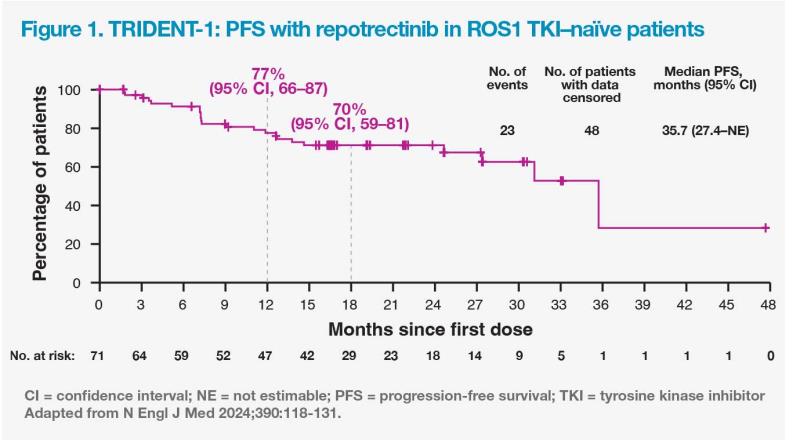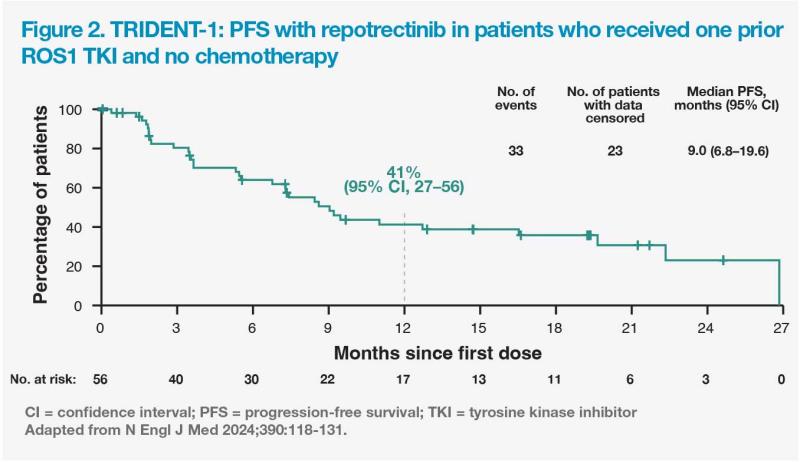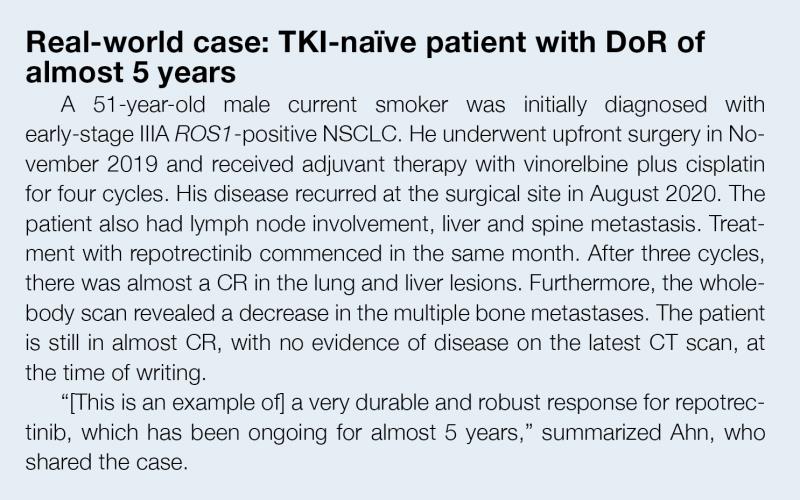Advances in ROS1-positive NSCLC treatment landscape















ROS1 rearrangement is an actionable mutation present in 2–3 percent of Chinese patients with advanced non-small-cell lung cancer (NSCLC). At an industry-sponsored meeting chaired by Dr Herbert Loong of the Department of Clinical Oncology at the Chinese University of Hong Kong (CUHK), experts discussed challenges in ROS1-positive NSCLC management, presented clinical data and shared real-world experience of using repotrectinib, a next-generation ROS1 tyrosine kinase inhibitor (TKI), in TKI-naïve and -experienced patients.
Challenges in ROS1-positive NSCLC management
ROS1 rearrangements occur in 2–3 percent of Chinese patients with NSCLC, who are typically younger and have never smoked. [Thorac Cancer 2018;10:47-53] “At public institutes within the Hospital Authority, as of the past year, every patient with NSCLC has next-generation sequencing [NGS] with ROS1 testing included,” noted Dr James Ho of the School of Clinical Medicine at the University of Hong Kong (HKU). “The NGS [that we use] is usually a lung cancer–specific panel that also incorporates RNA-based testing,” added Dr Molly Li of the Department of Clinical Oncology at CUHK.
Early-generation ROS1 TKIs (ie, crizotinib and entrectinib) achieved objective response rates (ORR) of 68–72 percent and duration of response (DoR) of 20–25 months. [Ann Oncol 2019;30:1121-1126; JTO Clin Res Rep 2022;3:100332] “However, all ROS1-positive tumours invariably develop acquired resistance to crizotinib or entrectinib. The predominant mechanism of resistance is the acquired G2032R mutation, which neither crizotinib nor entrectinib is active against,” said Professor Byoung-Chul Cho of Yonsei Cancer Center at Severance Hospital in Seoul, South Korea. [N Engl J Med 2024;390:118-131]
“Furthermore, early-generation ROS1 TKIs have very limited central nervous system [CNS] activity, with low concentrations of crizotinib reported in the cerebrospinal fluid. As a result, the CNS is the first and only site of progression in about half of crizotinib-treated patients,” he added. [J Clin Oncol 2011;29:e443-e445; J Thorac Oncol 2018;13:1717-1726] Of patients with disease progression limited to the CNS during previous crizotinib therapy, only 11 percent respond to entrectinib. [JTO Clin Res Rep 2022;3:100332]
Advancing ROS1-positive NSCLC care with a new TKI
“Repotrectinib is a small, rigid macrocyclic next-generation ROS1 TKI, which was designed to overcome the ROS1G2032R solvent front mutation,” stated Cho. [Cancer Discov 2018;8:1227-1236] Its small tyrosine kinase–binding interface allows repotrectinib to circumvent steric hindrance from ROS1 resistance mutations, which, in contrast to other ROS1 TKIs, enables potent inhibition of both wild-type and ROS1G2032R fusions. [Mol Cancer Ther 2021;20:2446-2456]
“According to data generated at my laboratory, repotrectinib demonstrated very important antitumour activity in an NSCLC patient cell–derived mouse xenograft tumour model with CD74-ROS1G2032R mutation acquired after 10 months of crizotinib treatment and in another model of acquired CD74-ROS1G2032R mutation after 7 months of entrectinib,” shared Cho. Furthermore, repotrectinib led to greater shrinkage of brain tumours and longer survival than entrectinib in a patient-derived ROS1 fusion–positive intracranial model. [Clin Cancer Res 2020;26:3287-3295]
Repotrectinib’s efficacy in ROS1 fusion–positive NSCLC was evaluated in the international, registrational phase I/II TRIDENT-1 trial. [N Engl J Med 2024;390:118-131]
Repotrectinib in TKI-naïve patients
TRIDENT-1’s primary efficacy population included 71 patients (median age, 57 years; women, 61 percent; never-smokers, 63 percent; brain metastases at baseline [BL], 24 percent) who had not previously received a ROS1 TKI and 56 TKI-experienced patients.
A confirmed response occurred in 79 percent of TKI-naïve patients, of whom 10 percent had a complete response (CR). At the median follow-up of 24.0 months, median DoR was 34.1 months. “At 18 months, 79 percent of patients were still in response, which I believe is an unprecedented result for a ROS1 TKI in the literature,” highlighted Cho.
The estimated 18-month progression-free survival (PFS) rate and overall survival (OS) rate were 70 and 88 percent, respectively. (Figure 1)

Of note, no ROS1 resistance mutations emerged during the repotrectinib treatment period in the 14 patients with disease progression who had not previously received a ROS1 TKI.
Repotrectinib in TKI-experienced patients
As well as the population of TKI-naïve patients, TRIDENT-1 also included 56 patients previously treated with one ROS1 TKI and no chemotherapy (median age, 57 years; women, 68 percent; never-smokers, 64 percent; brain metastasis at BL, 46 percent).
Among these patients, the confirmed response rate was 38 percent and CR rate was 5 percent. At a median follow-up of 21.5 months, median DoR was 14.8 months. At 12 months, the response rate was 56 percent, while the 12-month PFS and OS rates were 41 and 69 percent, respectively. (Figure 2)

“In the really hard-to-treat population of patients with ROS1G2032R mutation [n=17], the confirmed ORR was 58.8 percent, with a clinical benefit rate [defined as patients with complete or partial response or stable disease for ≥6 weeks] of 70.6 percent,” reported Cho.
Durable intracranial responses
Of patients with measurable brain metastasis at BL, an intracranial response occurred in 89 percent of TKI-naïve and 38 percent of TKI-experienced patients. At 12 months, 83 and 60 percent of these patients, respectively, were in intracranial response.
“To assess the potential of repotrectinib in preventing new CNS metastases, we should look at intracranial PFS in patients without brain metastasis at BL,” said Cho. “The 12-month PFS rates in the TKI-naïve and -experienced patients were 91 and 82 percent, respectively. Furthermore, first intracranial progression alone did not occur in any TKI-naïve or -pretreated patients within 18 months of repotrectinib treatment.”
When is the optimum time to use repotrectinib?
During the panel discussion, the majority of experts agreed that using repotrectinib upfront was the optimal sequencing strategy.
“Using repotrectinib in the first line would provide the longest PFS and DoR, and can potentially prevent CNS progression. If you use crizotinib or entrectinib first, the patient would progress with G2032R mutation, at which point repotrectinib use would confer a PFS of only 6–7 months, meaning repotrectinib’s efficacy is dramatically reduced in the second vs first line. All the data on PFS, DoR, CNS activity, and prevention of emergence of G2032R mutation justify first-line use of repotrectinib vs other ROS1 TKIs, in my opinion,” explained Cho.
“In spite of the wonderful intracranial response achieved [with repotrectinib after criztonib], the PFS is much shorter in the second line compared with the first line,” shared Professor Beung-Chul Ahn of the Department of Internal Medicine, Center for Lung Cancer at the National Cancer Center in Goyang-si, South Korea, when describing one of his patient cases.
“It does seem that the treatment-naïve setting is probably a better position to use repotrectinib. It has certainly shown good CNS activity – and potential prevention of brain metatasis would be a good reason to prescribe repotrectinib in the TKI-naïve setting, as we want to avoid that as much as possible,” summarized Loong.
Tolerability: Practical tips
In the TRIDENT-1 trial, repotrectinib’s most common treatment-related adverse events (AEs) of any grade were dizziness (58 percent), dysgeusia (50 percent), and paraesthesia (30 percent). Two-thirds of AEs were of grade 1/2. Grade ≥3 dizziness occurred in 3 percent of patients, but dizziness did not lead to any repotrectinib discontinuations.
“Dizziness is a manageable side effect,” said Cho and Ahn.
“Overall, in TRIDENT-1, patients’ general health status and quality of life [QoL] were relatively stable over 24 cycles of repotrectinib. There was also a meaningful improvement in lung cancer–related symptoms in patients treated with repotrectinib,” added Cho.
“Dose modification is a useful mitigation strategy for dizziness. For instance, repotrectinib 160 mg BID can be reduced to 120 mg BID, and once there is no impact on QoL and daily activity, the dose can be increased again, to protect the CNS. Oral hydration and antihistamines may also help in some patients. Many of my patients adapt to dizziness in daily life,” shared Ahn.
“At our institution, if dizziness occurs, it tends to be within the first 1–2 months of treatment. After the patients have had a dose reduction and are then rechallenged with the original dose, the dizziness is not as severe as before,” added Loong.
The discussants highlighted that there are clear published guidelines on how to manage toxicities with dose reduction and remarked that the 40 mg pills allow for easy fine-tuning of uptitration and downtitration of the dose and help avoid a big dose reduction. [Augtyro Hong Kong Prescribing Information]
